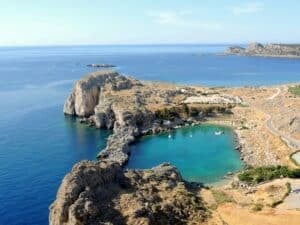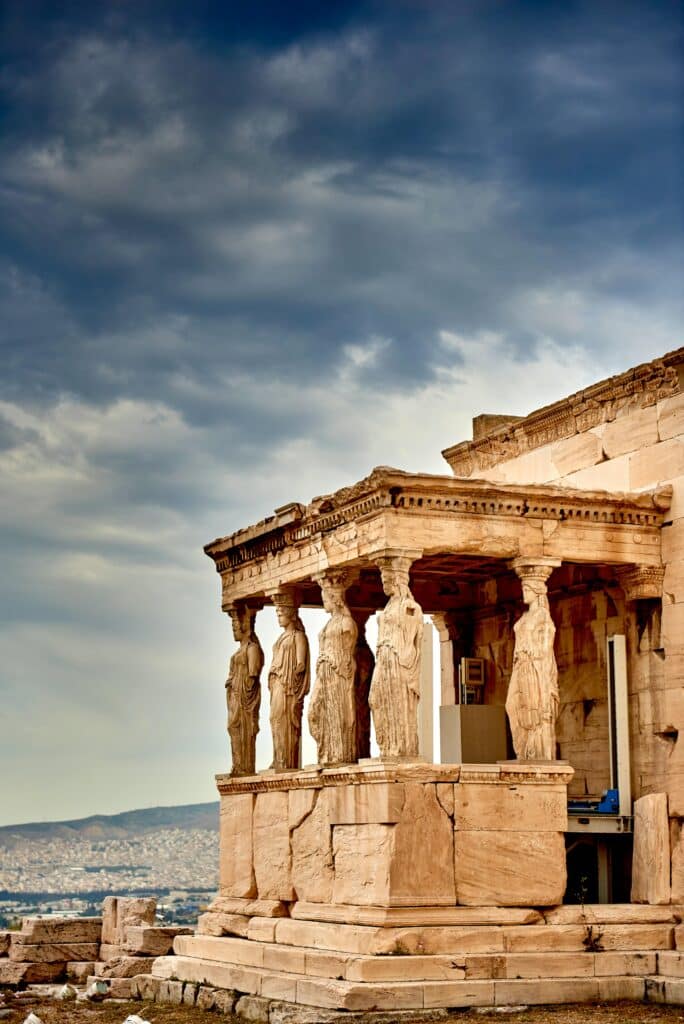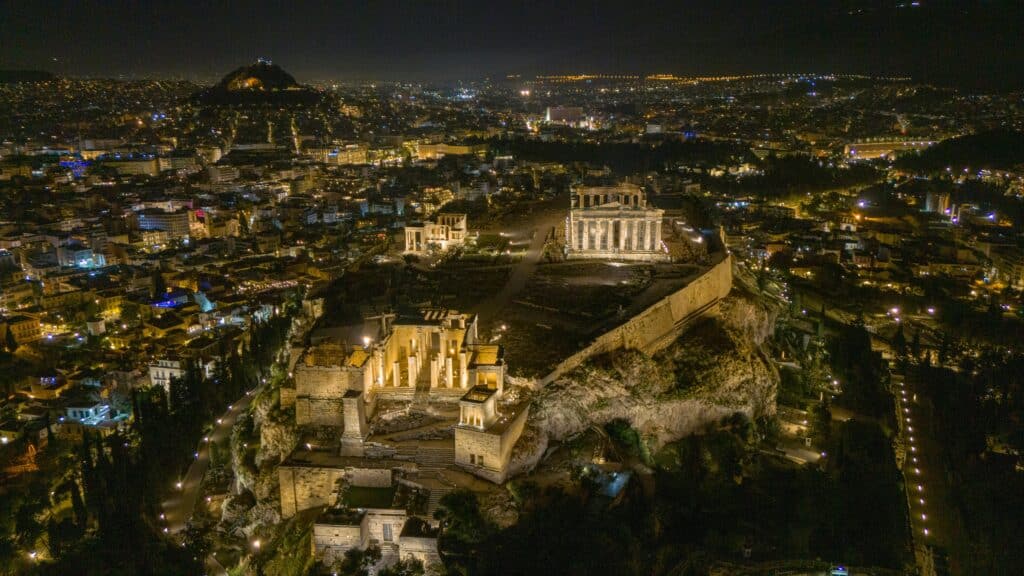The birth of the Athens Acropolis: An ancient masterpiece
Construction of the Acropolis in Athens began in the 5th century BC, under the direction of Pericles. This was a period of cultural and political renewal. It was the golden age of Athenian civilization, also known as the “Age of Pericles”. Athenian democracy flourished and Athens became the center of the Greek world. The Acropolis project transformed the sacred hill into a monumental complex, symbolizing the grandeur of the city.
The aim of the project is to pay homage to Athena, the city’s protector, after the victory over the Persians. The victories at Marathon (490 BC) and Salamis (480 BC) marked a military and cultural triumph. These battles represent Greek resistance to the Persian Empire.
The Parthenon: A Monument to Victory
At the heart of this monumental project is the Parthenon, the temple dedicated to Athena. Architects Ictinos and Callicrates designed the temple, which was completed in 432 B.C. This masterpiece of Doric architecture is the pride of Athens. It is 69.5 metres long and 30.9 metres wide. The giant statue of Athena, by Phidias, is almost 12 metres high. It is made of gold and ivory.
The Parthenon symbolizes not only victory over the Persians, but also homage to the goddess Athena Parthenos. The Acropolis, a religious center, was both a sacred site and a showcase for the greatness of Athens. This project strengthened Athens’ position within the Delos Confederation, a defensive alliance against Persian invasions.
Anecdote on Construction and Challenges
The construction of the Acropolis was an ambitious project, carried out against a backdrop of war and political tension. The project was largely financed by funds from the Delos confederation. Athens used these defense funds to finance its grandiose plans. This provoked criticism from the Greek allies. Construction took around 9 years, a relatively short time for a work of this scale. The project required the employment of hundreds of craftsmen, sculptors, stonemasons and masons.
It’s fascinating to note that during construction, artists corrected visual illusions. For example, the columns of the Parthenon are not straight. They are slightly curved to compensate for the visual effect that would make them appear thinner. This optical construction technique has made the Parthenon a unique example of architectural harmony.
The Pericles Legacy: A Political and Cultural Problem Solved
Under Pericles’ leadership, the Acropolis was not just a place to celebrate Athena. It also symbolized the power and prosperity of Athens. Pericles wanted to reinforce the political cohesion of Athens at a time of great instability. He therefore called on artists and craftsmen from all over Greece. This project culturally unified the entire ancient Greek world.
The Acropolis of Athens: A Monument in the Heart of the City
The Acropolis of Athens lies at the heart of the city, on a rocky hill rising some 156 metres above sea level. This elevated position allows the Acropolis to dominate the city, offering spectacular views of Athens and its surroundings. The view extends to the surrounding mountains and the Aegean Sea. The Acropolis hill has always been a strategic location, both militarily and religiously.
The Acropolis is located in the historic Plaka district, one of the city’s oldest. It is easily accessible from the city center. Its central location makes it a must for visitors, whether they’re coming from the airport or the surrounding tourist areas.
A site steeped in history and symbolism
The Athenians have always regarded the Acropolis hill as a central natural site in the city’s history. Even before the construction of the monuments in the 5th century BC, they dedicated the Acropolis to sacred cults. Traces of these ancient cults, dating back to the Bronze Age, have been found, proving that the site was worshipped long before classical times.
The Athenians chose the Acropolis as a sanctuary dedicated to their gods. They chose this site for its strategic position, easy to defend and visible from all parts of the city. This made the Acropolis a major religious center and a symbol of Athens’ power and prosperity.
Exceptional views and tourist appeal
Today, the Acropolis remains one of Greece’s main tourist attractions, attracting millions of visitors every year. Its majestic Parthenon and other monuments make it a must-see in Athens. The view from the Acropolis is breathtaking. Not only can you see Athens, but also famous sites such as the Temple of Olympian Zeus, the Panathenaic Stadium and the Parnes Mountains to the north.
The climb up to the Acropolis also allows you to discover ancient ruins, museums and archaeological sites. These include the Ancient Agora, the Theatre of Dionysus and the Temple of Hephaestus. Every step towards the summit is a journey through the fascinating history of Athens, spanning Greek culture, politics and mythology.
Features of the Athens Acropolis
The Parthenon: Symbol of Greek Civilization
The Parthenon is the most famous temple on the Acropolis. Architects built this Doric temple, dedicated to Athena Parthenos, between 447 and 432 BC under the direction of Ictinos and the sculptor Phidias. The Parthenon is 69.5 metres long and 30.9 metres wide. The Doric colonnades create an impression of strength and balance.
The Parthenon was not only a place of worship for Athena, but also a symbol of Greek victory over the Persians. Inside was a gigantic statue of Athena, created in gold and ivory by Phidias, measuring almost 12 meters. Exterior sculptures, such as friezes and metopes, depict mythological scenes. These include the sacrifice of Iphigenia, the battle of the Lapiths against the Centaurs, and the Trojan War.
The Erechtheion: Symbolic Architecture
The Erechtheion is a major temple built between 421 and 406 BC. The architects dedicated the temple to Athena, Poseidon, Erechtheus (a mythical king) and Hephaestus, the god of fire. The temple is distinguished by its religious depth and its southern façade, which features the Caryatids. These six female statues serve as columns supporting the temple roof. They are sculpted with great finesse, combining art and architectural function.
The Erechtheion perfectly illustrates the fusion of religious symbolism and architectural innovation.
The Temple of Athena Nike: Elegance and Victory
The Temple of Athena Nikè is a small temple, but just as impressive for its elegance and symbolism. Built around 427 BC, it is dedicated to the goddess Nikè, goddess of victory. This Ionic temple is distinguished by its light structure and friezes depicting battle scenes. It depicts the victory of the Greeks over the Persians at the battles of Marathon and Salamis.
The temple is located on the south-western portico of the Acropolis. This location symbolically marks the victory of the Athenians. The sculpture of Nikè, depicted without wings, embodies a silent triumph. It thus becomes a symbol of lasting victory for the city.
The Acropolis Fountain and Other Structures
In addition to the major monuments, the Acropolis is home to a number of important secondary structures. These include the Acropolis Fountain, which supplied water to the sanctuary’s inhabitants. The propylaea, the monumental entrance to the Acropolis, are an example of grandiose architecture. Although unfinished, they marked the entrance to a sacred site, underlining the power of Athens.
What makes the Athens Acropolis such an iconic site
The Acropolis of Athens stands out not only for its beauty and history. It stands out for the ingenuity of its architects and sculptors. They have combined advanced techniques and aesthetics to create timeless monuments. The ancient Greeks perfected the art of construction. This is reflected in the structures of the Acropolis, particularly the Parthenon.
Advanced Architectural Techniques : The Art of Harmony
Greek architects mastered mathematical and geometrical principles to create monuments of perfect harmony. They applied the golden ratio, a proportion renowned for its beauty and balance, with great precision. This golden ratio gave the Parthenon ideal proportions. The dimensions of length, width and height were carefully calculated to create a harmonious visual effect.
Optical Illusion: Correcting Visual Distortions
The Acropolis, and particularly the Parthenon, is a perfect example of optical construction. This technique corrects visual distortions that appear at a distance. Architects have studied the way the human eye perceives structures. They have modified certain elements to compensate for these illusions. For example, the columns of the Parthenon are not straight. They are slightly curved outwards, creating the illusion of perfectly straight columns when viewed from a specific angle.
The foundations of the Parthenon were designed to be slightly convex. This corrects the illusion of distorted straight lines. These adjustments ensure that, even under intense sunlight, the temple appears perfectly balanced, with no distortion perceptible from a distance.
Architectural and Artistic Innovation
This sense of harmony and precision in construction testifies to the importance of aesthetics and symbolism in ancient Greek culture. The Parthenon, though a religious temple dedicated to Athena, also symbolizes the grandeur of Athens. It represents the power of Athenian democracy. The Greeks wanted to convey that their civilization was as perfect and balanced as their buildings.
Sustainable Impact on Modern Architecture
The Acropolis, and in particular the Parthenon, has not only influenced generations of the ancient world. Contemporary architects and artists still draw inspiration from it today. The ancient Greeks developed many architectural principles, such as the use of proportion and visual harmony, which are still applied today. The Parthenon symbolizes architectural perfection and serves as a model of aesthetic rigor.
Building techniques: the ingenuity of Greek architects
The construction techniques used on the Acropolis were revolutionary for their time. They bear witness to the mastery of Greek architects. The Acropolis was not just a collection of religious buildings, but an ambitious work of architecture. Built without modern technology, it continues to inspire the world. The architects of the Acropolis created structures of unrivalled precision and beauty.
The Symmetry and Balance of the Parthenon
The Parthenon is a marvel of symmetry and balance. The Greek architects paid extreme attention to the harmony of every detail. They designed the temple according to a plan of perfect symmetry, with precise mathematical relationships between its various parts. The columns of the Parthenon are arranged with such precision that the architects incorporated even small variations to create the illusion of perfect regularity. This phenomenon is known as “optical construction”.
The architects also adjusted the design of the columns to correct visual illusions. For example, the columns are slightly domed in the center. Their spacing was calculated to prevent the temple from appearing to sag. This attention to detail testifies to the genius of the architects, who used geometrical principles to ensure perfect aesthetics from every angle.
Materials: carefully selected for durability
The architects carefully selected the materials used to build the Acropolis, giving priority to durability and aesthetics. Pentele marble, used in the construction of the Parthenon, is a white stone renowned for its quality and strength. Craftsmen extracted this marble from the surrounding mountains, appreciated for its clarity and brilliance. This marble allowed the sculptures and architectural details to shine in the sunlight.
The choice of marble was not only aesthetic. The material is weather-resistant. The Acropolis, located on a hill exposed to the elements, required an ideal material to guarantee the longevity of the structures.
Advanced Techniques for the Construction of Monuments
A major innovation lies in the way the stones are assembled. Greek architects carved the stone colossi of the Parthenon with such precision that the stones fit together perfectly without mortar. The craftsmen used simple tools, but their mastery of proportions enabled them to achieve impressive precision.
The sculptures and decorative details that adorn the Parthenon and other buildings on the Acropolis were also executed with the utmost attention to detail. The metopes, friezes and sculptures on the pediments depict mythological scenes and battles. They bear witness to the artistic refinement and sculptural technology of the period.
A Collective Construction: A Large-Scale Project
The Acropolis was not built by a single architect, but by a team of specialized craftsmen. Masons, sculptors, stonemasons, carpenters and metalworkers all contributed to this collective work. Each was a master in his own field.
The Athenians mobilized considerable manpower and financial resources for this project. Funding came in part from the Delos Confederation, a military and economic alliance formed to defend Greece.
An Unequalled Legacy: A Model for Modern Architecture
The construction techniques used on the Acropolis, and in particular the Parthenon, have left their mark on architectural history. They continue to influence modern architecture. The principles of perfect proportions, material assembly and optical illusion made the Acropolis a model of architectural perfection. Today, architects still study these principles to reproduce the precision and balance of ancient Greek constructions.
Bronze and Marble: The Artistic Mastery of Greek Sculptors
The Parthenon’s marble sculptures represent one of the greatest artistic achievements of ancient Greece. These works of art continue to influence modern artists and architects. The metopes, friezes and pediments of the Parthenon illustrate the virtuosity of Greek sculptors. They captured mythological and historical scenes in a way that was unique for their time.
Metopes: Mythological scenes carved in marble
The Parthenon’s metopes decorate the temple and depict mythological scenes. The architects placed these metopes on all four sides of the temple, depicting battles between heroes and mythological creatures.
On the south façade, the metopes depict the battle of the Lapiths against the Centaurs, symbolizing the struggle between civilization and barbarism. The metopes on the west side depict the Battle of Troy, while those on the north side relate the labors of Heracles. These metopes are examples of sculptural precision, showing how Greek artists captured movement and emotion with simple, powerful forms.
Friezes: The Art of Detail and Movement
The Parthenon friezes decorate the exterior of the cella and depict the Panathenaeus procession. This religious festival celebrated Athena and the unity of Athens. The friezes are famous for their realistic depiction of human figures, with natural, dynamic poses.
The sculptural details – such as the expressive faces and subtle movements of horses and athletes – demonstrate the sculptors’ mastery of human and animal anatomy. Each figure seems in motion, almost alive, demonstrating the harmony and mastery of Greek sculptors.
Les Frontons : Monumental mythological scenes
The Parthenon’s pediments, placed at the top of each façade, illustrate the founding myths of ancient Greece. On the eastern pediment, the sculptors depict the birth of Athena from the head of Zeus. This myth symbolizes the birth of Athens’ patron goddess and underlines the city’s importance in the Greek world. The human and divine figures are positioned to accentuate the dramatic effect of the scene.
On the west pediment, the sculptors depicted the competition between Poseidon and Athena for the protection of Athens. The highly symmetrical scene highlights the artists’ ability to combine art and architecture.
Bronze and the Evolution of Marble: An Inseparable Duo
The sculptors of the Parthenon created famous marble sculptures, but they also used bronze, an essential material in Greek art of the time. The artists chose bronze for their dynamic sculptures. They first created certain parts of the Parthenon statues, such as the horses in Athena’s chariot, in bronze, then replaced them with marble versions.
Greek sculptors used bronze to create statues in motion. This material enabled them to capture fine details, such as floating clothes or hair moving in the wind. Bronze also brought a natural lustre to sculptures, accentuating their realism and beauty.
The Legacy of the Parthenon Sculptors
The sculptors of the Parthenon, led by Phidias, had a profound influence on Western art. Their ability to marry aesthetics and religious function in every sculptural detail made the Parthenon one of the greatest masterpieces in the history of art. Their work continues to inspire generations of artists and architects, setting standards of harmony, proportion and realism that endure to this day.
Local and Ecological Resources: Greek Ingenuity in the Use of Materials
The architects and engineers of the Athens Acropolis have demonstrated exceptional mastery of local resources. These materials were chosen for their natural properties. They not only ensured the durability of the structures, but also contributed to the beauty and symbolism of the site.
Pentelic marble: a material of exceptional quality
The marble used in the construction of the Acropolis comes from the quarries of the Pentelic mountain, located 10 kilometers northeast of Athens. This extremely pure white marble was quarried and used for the Parthenon and other temples on the Acropolis.
This marble is particularly luminous. It has a natural brilliance that captures sunlight in a unique way. Under the sun’s rays, it seems to light up the Acropolis. This phenomenon is particularly visible at sunset, when the monuments take on a golden hue, reinforcing the majestic aura of the site.
Pentelic marble is also very resistant. This has contributed to the longevity of the structures. It is resistant to weather, earthquakes and climate change. This marble has helped preserve monuments for over two millennia.
Transporting marble: a logistical tour de force
Transporting the marble from the quarries to the Acropolis was a technical challenge. The Greeks used a ramp system to move the heavy blocks of marble. They transported the blocks on wooden sledges and wheels, which were used to roll along prepared tracks.
Craftsmen extracted the blocks from the quarries, then moved them by these sledges. This system made it possible to move large quantities of marble while minimizing the risk of breakage. Greek ingenuity was also evident in the use of rivers and canals to facilitate transport. Ships transported marble from the port of Piraeus.
Other Local Materials: Environmentally-friendly Construction
In addition to marble, architects used other local materials to build the Acropolis. Limestone, easier to carve than marble, was used for the foundations and certain decorative elements. Granite, which is harder, was used for smaller sculptures and special details.
The ancient Greeks were highly efficient in their use of locally available materials. In so doing, they reduced ecological impact while creating a majestic site, respecting the principles of sustainability in their construction.
Sustainability and Legacy: Architecture that Stands the Test of Time
Thanks to local resources and ecological materials, the Acropolis remains an example of sustainable architecture. The Greeks’ ability to use sustainable materials and their innovative techniques have enabled these monuments to stand the test of time.
Today, these buildings continue to inspire modern architects. They seek to combine aesthetics, sustainability and respect for natural resources, just as the Greeks did over 2,500 years ago.
How long did the Acropolis of Athens remain intact?
The Acropolis of Athens has survived centuries of war, looting and natural disasters. Although a number of events have damaged certain buildings, a great deal of effort has gone into restoring and preserving this historic site. Thanks to these efforts, the Acropolis remains a witness to the splendor of ancient Greek civilization, surviving the ages with resilience.
Challenges facing the Acropolis: War and pillage
The Acropolis underwent several assaults, notably during the Peloponnesian War (431-404 BC). However, it was not until Roman rule that the Acropolis really began to deteriorate. The Romans respected the existing structures, but sometimes modified certain elements. Later, under the Byzantine Empire, several buildings were converted into churches, causing further damage. The Acropolis has survived various eras and dominations while retaining much of its sacred character.
The Damage of the Modern Age: The Explosion of 1687 and Other Catastrophes
The greatest damage to the Acropolis occurred in 1687, during the Ottoman occupation of Greece. During the war with the Venetians, a shell hitting the Parthenon, used as an ammunition store, caused a massive explosion. This caused the roof and parts of the temple to collapse. The explosion severely damaged the structure, including the pediments and friezes.
After this incident, the Acropolis continued to be exposed to weather, earthquakes and pollution. These factors have exacerbated damage over the centuries.
Restoration efforts: a constant commitment to preservation
Following Greece’s independence in 1830, the authorities launched a vast restoration program to stabilize and repair the monuments of the Acropolis. These efforts were amplified throughout the 19th and 20th centuries, with particularly notable work in the 1970s. Researchers and archaeologists used modern techniques to reinforce the structures while respecting the historical integrity of the Acropolis.
Restoration work on the Parthenon has enabled lost sculptures to be replaced and weakened structures to be adjusted. Modern technologies, such as 3D imaging, have also been used to analyze the monuments and prevent future damage.
The Acropolis Today: A Symbol of Resilience
The Acropolis in Athens continues to attract millions of visitors every year. It bears witness not only to the grandeur of ancient Athens, but also to the resilience of its monuments. Restoration efforts continue, ensuring the site is protected for future generations. These efforts have ensured that the Acropolis remains an icon of ancient Greek civilization and a source of inspiration for modern architecture.
Thanks to conservation work, the Acropolis remains an example of architectural resilience. It continues to inspire architects and researchers the world over as they seek to understand how to preserve such complex and majestic structures.
Practical information for visiting the Athens Acropolis
The Athens Acropolis is one of Greece’s most popular tourist attractions. Before planning your visit, it’s important to know some practical information, including opening times, prices and tips on how to make the most of your experience.
Opening hours
The Acropolis is open every day of the year, with the exception of certain national holidays. Opening times are generally as follows:
- High season (April to October): 8 a.m. to 8 p.m.
- Low season (November to March): 8 a.m. to 5 p.m.0 p.m.0
We recommend visiting early in the morning or late in the day to avoid the crowds and take advantage of the ideal light for photos.
Admission fees
Admission to the Acropolis may vary according to the season and discounts applied. Here are the general rates:
- Standard admission: €20 (high season)
- Reduced admission: €10 (for European students, young people aged 6 to 25, etc.).
- Free admission: Visitors under 6, European Union residents over 65, and on special days (such as Archaeology Day in April).
The Acropolis also offers a multipass that gives reduced-rate access to other archaeological sites in Athens (such as the Agora, the Temple of Olympian Zeus, the Panathenaic Stadium, etc.):
- High-season Multipass: €30
- Low-season Multipass: €15
Practical tips for visiting the Acropolis
In the morning, as soon as it opens, or in the late afternoon, temperatures are more pleasant and the site is less crowded.
The Acropolis is an elevated site, with steep staircases and uneven terrain. Appropriate footwear will help you make the most of your visit.
- Bring water and sunscreen
The site is often exposed to the sun, especially during the hot summer months. Take precautions to avoid dehydration and sunburn.
- Take advantage of our guided tours
A guided tour is highly recommended to learn more about the history and significance of the monuments. Experienced guides offer tours in French, English and other languages.
Don’t miss the Acropolis Museum, just a few minutes’ walk from the site. This modern museum houses sculptures and artifacts found on the site, giving you a better understanding of the history of the Acropolis.
Accessibility and Transportation
The Acropolis is easily accessible from the center of Athens. Here are the main options for getting there:
The Acropoli station (line 1) is just a few steps from the main entrance.
Several bus routes serve the Acropolis, including X95 and L1.
Cabs are also a convenient way of getting directly to the Acropolis.
The site is accessible to people with reduced mobility thanks to ramps and adapted paths.
Best time to visit the Acropolis
The best time to visit the Acropolis is during the low season, from November to March, when visitor numbers are lower and temperatures more pleasant. However, even in high season, early morning or late afternoon are ideal times to avoid the crowds.
If you’re a photography enthusiast, the golden hour at sunset offers magnificent light that sublimates the ancient structures. What’s more, monuments such as the Parthenon glisten in the afternoon sun, offering spectacular views.
Virtual and Digital Tours
If you can’t make it to Athens, or if you’d like to prepare for your visit, the Athens Acropolis offers online virtual tours. These digital experiences let you explore the iconic monuments and learn about their history from the comfort of your own home. You can also use augmented reality applications for an immersive visit before you go on site.















